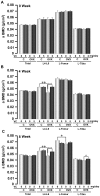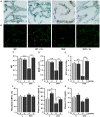Vitamin C prevents hypogonadal bone loss
- PMID: 23056580
- PMCID: PMC3466266
- DOI: 10.1371/journal.pone.0047058
Vitamin C prevents hypogonadal bone loss
Abstract
Epidemiologic studies correlate low vitamin C intake with bone loss. The genetic deletion of enzymes involved in de novo vitamin C synthesis in mice, likewise, causes severe osteoporosis. However, very few studies have evaluated a protective role of this dietary supplement on the skeleton. Here, we show that the ingestion of vitamin C prevents the low-turnover bone loss following ovariectomy in mice. We show that this prevention in areal bone mineral density and micro-CT parameters results from the stimulation of bone formation, demonstrable in vivo by histomorphometry, bone marker measurements, and quantitative PCR. Notably, the reductions in the bone formation rate, plasma osteocalcin levels, and ex vivo osteoblast gene expression 8 weeks post-ovariectomy are all returned to levels of sham-operated controls. The study establishes vitamin C as a skeletal anabolic agent.
Conflict of interest statement
Figures



References
-
- The Asian Audit. Epidemiology, Costs and Burden of Osteoporosis in Asia 2009 (China). International Osteoporosis Foundation. http://www.osteofound.org/asian-audit. Accessed 2012 Sep 12.
-
- Fain O (2005) Musculoskeletal manifestations of scurvy. Joint Bone Spine 72: 124–128. - PubMed
-
- Morton DJ, Barrett-Connor E, Schneider DL (2001) Vitamin C supplement use and bone mineral density in post-menopausal women. J Bone Min Res 16: 135–140. - PubMed
-
- Simon JA, Hudes ES (2001) Relation of ascorbic acid to bone mineral density and self-reported fractures among US adults. Am J Epidemiol 154: 426–233. - PubMed
Publication types
MeSH terms
Substances
Grants and funding
LinkOut - more resources
Full Text Sources
Medical

